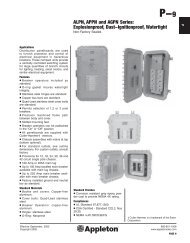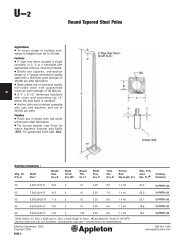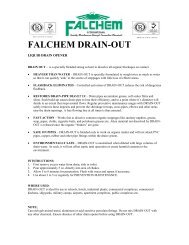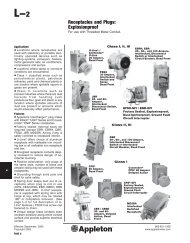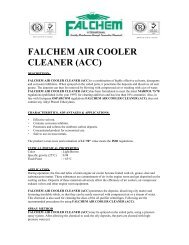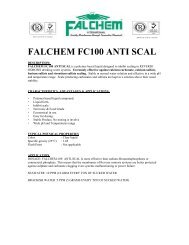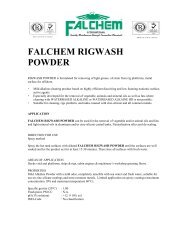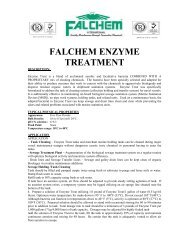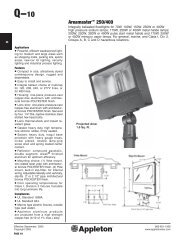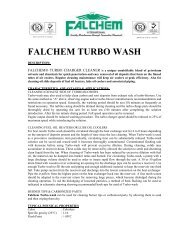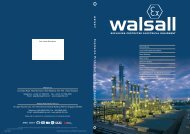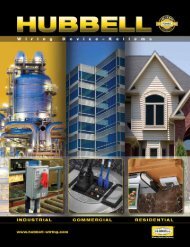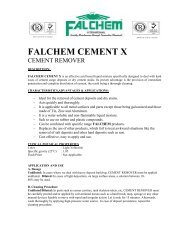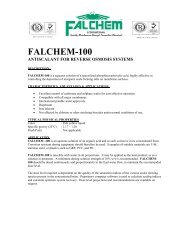Untitled
Untitled
Untitled
Create successful ePaper yourself
Turn your PDF publications into a flip-book with our unique Google optimized e-Paper software.
Technical Information 7.01<br />
Technical Information
7.02 Technical Information<br />
European Quality Standards<br />
Product Standards<br />
(simplified and based on 10 x 10 cm (BIII),<br />
or 30 x 30 cm (BI))<br />
A) Dimensions + Surfaces<br />
1. Length and Width<br />
2. Thickness<br />
3. Straightness of Edges<br />
4. Rectangularity<br />
5. Surface Flatness<br />
5.1 Curvature at Centre<br />
5.2 Curvature at the Edges<br />
5.3 Skewness<br />
6. Surface Quality<br />
7. Colour Deviations<br />
7.1 Colour Shade Grading<br />
8. Size Grading 1)<br />
group AI a + AI b<br />
“Nature” “Precision”<br />
± 2% | ±1.0%<br />
± 10% | ± 10%<br />
± 0.6% | ± 0.5%<br />
± 1.0% | ± 1.0%<br />
± 1.5% | ± 0.5%<br />
± 1.5% | ± 0.5%<br />
± 1.5% | ± 0.8%<br />
at least 95%<br />
Extruded Ceramic Tiles<br />
•<br />
•<br />
•<br />
DIN EN 14411<br />
group AII a - part 1<br />
“Nature” “Precision”<br />
± 2% | ±1.25%<br />
± 10% | ± 10%<br />
± 0.6% | ± 0.5%<br />
± 1.0% | ± 1.0%<br />
± 1.5% | ± 0.5%<br />
± 1.5% | ± 0.5%<br />
± 1.5% | ± 0.8%<br />
at least 95%<br />
•<br />
•<br />
•<br />
Dry-pressed Ceramic Tiles<br />
group BI a + BI b<br />
± 0.75%<br />
± 5%<br />
± 0.5%<br />
± 0.6%<br />
± 0.5%<br />
± 0.5%<br />
± 0.5%<br />
at least 95%<br />
•<br />
•<br />
•<br />
DIN EN 14411<br />
group B III<br />
± 0.75%<br />
± 10%<br />
± 0.3%<br />
± 0.5%<br />
+ 0,5/-0,3%<br />
+ 0,5/-0,3%<br />
± 0.5%<br />
at least 95%<br />
•<br />
•<br />
•<br />
Test Standards<br />
DIN EN ISO 10545-2<br />
DIN EN ISO 10545-2<br />
DIN EN ISO 10545-2<br />
DIN EN ISO 10545-2<br />
DIN EN ISO 10545-2<br />
DIN EN ISO 10545-2<br />
DIN EN ISO 10545-2<br />
DIN EN ISO 10545-2<br />
DIN EN ISO 10545-2<br />
DIN EN ISO 10545-16<br />
Deutsche Steinzeug<br />
Deutsche Steinzeug<br />
B) Physical Properties<br />
1. Water Absorption on average /<br />
max. individual<br />
value<br />
2. Modulus of<br />
Rupture<br />
Value in brackets =<br />
min. individual<br />
value<br />
2.1.Breaking Strength ≥ 7.5 mm<br />
AI a E ≤ 0.5%/0.6%<br />
AI b 0.5% < E ≤ 3%/3.3%<br />
AI a min.28 (21)N/mm 2<br />
AI b min.23 (18)N/mm 2<br />
AI a min.1300 N<br />
≤ 6/6.5%<br />
min. 20 (18)N/mm 2<br />
at least 950 N<br />
BI a ≤ 0.5%<br />
BI b ≤ 3%<br />
BI a min.32 N/mm 2<br />
BI b min. 27 N/mm 2<br />
BI a min.1300 N<br />
glazed<br />
> 10%<br />
Thick. – 7.5mm:12N/mm 2<br />
at least 600 N<br />
DIN EN ISO 10545-3<br />
DIN EN ISO 10545-4<br />
DIN EN ISO 10545-4<br />
thickness<br />
2.2.Breaking Str. < 7.5 mm thickn.<br />
3. Resistance to Shock<br />
4. Resistance to Deep Abrasion<br />
5. Resistance to Glaze Abrasion<br />
6. Max. Coefficient of Expansion<br />
7. Thermal Shock Resistance<br />
8. Moisture Expansion<br />
9. Resistance to Glaze Cracking 2)<br />
10. Thermal Conductivity<br />
11. Electrical Leakage Resistance<br />
12. Steam Diffusion Resistance<br />
13. Resistance to Frost<br />
14. Light and Colour Fastness<br />
15. Luminance<br />
16. Behaviour in Fire<br />
AI b min. 1100 N<br />
at least 600 N<br />
•<br />
≤ 275 mm 3<br />
0-5<br />
•<br />
•<br />
< 0.001mm/m<br />
required<br />
appr. 1 W/mK<br />
> 10 10 Ohm 4)<br />
appr. µ 120.000<br />
required<br />
•<br />
acc. to specifications<br />
A1 non-combustible<br />
at least 600 N<br />
•<br />
≤ 393 mm 3<br />
0-5<br />
•<br />
•<br />
< 0.001mm/m<br />
required<br />
appr. 1 W/mK<br />
> 10 10 Ohm 4)<br />
appr. µ 120.000<br />
not required, but met by<br />
AGROB BUCHTAL<br />
•<br />
acc. to specifications<br />
A1 non-combustible<br />
BI b min. 1100 N<br />
at least 700 N<br />
•<br />
≤ 175 mm 3<br />
0-5<br />
•<br />
•<br />
appr. 0.001mm/m<br />
required<br />
appr. 1 W/mK<br />
10 10 Ohm<br />
appr. µ 120.000<br />
required<br />
•<br />
acc. to specifications<br />
A1 non-combustible<br />
at least 200 N<br />
•<br />
–<br />
0-5<br />
•<br />
•<br />
appr. 0.01mm/m<br />
required<br />
appr. 0.8 W/mK<br />
10 10 Ohm<br />
appr. µ 100.000<br />
–<br />
•<br />
acc. to specifications<br />
A1 non-combustible<br />
DIN EN ISO 10545-4<br />
DIN EN ISO 10545-5<br />
DIN EN ISO 10545-6<br />
DIN EN ISO 10545-7<br />
DIN EN ISO 10545-8<br />
DIN EN ISO 10545-9<br />
DIN EN ISO 10545-10<br />
DIN EN ISO 10545-11<br />
Deutsche Steinzeug<br />
DIN EN 1081<br />
DIN EN ISO 12572<br />
DIN EN ISO 10545-12<br />
DIN 51094<br />
Deutsche Steinzeug<br />
DIN 4102<br />
Technical Information<br />
C) Chemical Properties 3)<br />
1. Resistance to Chemicals<br />
2. Resistance to Household Chemicals<br />
and Bath Water Additives<br />
3. Stain Resistance (glazed)<br />
4. Lead and Cadmium Delivery<br />
5. Hydrotect<br />
D) Slip resistance<br />
1. Coefficient of Friction<br />
1.1 Industrial Areas (BG)<br />
Trade Associations<br />
1.2 Barefoot Areas (BUK)<br />
German National Association of<br />
Accident Insurance Companies<br />
see test certificate<br />
min. GB or UB<br />
min. Cl. 3<br />
•<br />
see test certificate<br />
•<br />
Groups R9-13/V4-10<br />
Groups A/B/C<br />
1) Boxes marked according to size and colour shade.<br />
2) Exceptions are marked.<br />
3) Hydrofluoric acid and its compounds excluded.<br />
4) Exceptions:<br />
Eladuct/KerAion: ELA 10.6: 10 6 Ohm; colours 958, 070S: 10 8 Ohm.<br />
see test certificate<br />
min. GB or UB<br />
min. Cl. 3<br />
•<br />
see test certificate<br />
•<br />
Groups R9-13/V4-10<br />
Groups A/B/C<br />
see test certificate<br />
min. GB or UB<br />
min. Cl. 3<br />
•<br />
see test certificate<br />
•<br />
Groups R9-13/V4-10<br />
Groups A/B/C<br />
see test certificate<br />
–<br />
min. Cl. 3<br />
•<br />
see test certificate<br />
•<br />
–<br />
–<br />
–<br />
DIN EN ISO 10545-13<br />
DIN EN ISO 10545-14<br />
DIN EN ISO 10545-15<br />
Deutsche Steinzeug<br />
DIN EN ISO 10545-17<br />
DIN 51130<br />
BGR 181<br />
DIN 51097<br />
GUV-I 8527<br />
Deutsche Steinzeug tiles present better values than required by<br />
the standards.<br />
In addition, they are construction biologically, ecologically, hygienically<br />
and bacteriologically safe; this is guaranteed through the choice of<br />
raw materials, method of processing and firing technique.<br />
Price list 2010, status December 2009
Technical Information<br />
7.03<br />
Terms and Classification according to DIN EN 14411<br />
All our tiles are processed, refined and fired building materials of<br />
natural mineral origins such as clay, quartz sand and flux. Depending<br />
on the application they are manufactured with a glazed (GL)<br />
or unglazed (UGL) surface. They can be classified in accordance<br />
with DIN EN 14411 as follows:<br />
Classification of the ceramic tiles according to their<br />
groups of water absorption (E) and their shaping<br />
Shaping group I group II a group II b group III<br />
E ≤ 3% 3% < E ≤ 6% 6% < E ≤ 10% E > 10%<br />
group AI a group AII a-1<br />
a) group AII b-1<br />
a)<br />
A E ≤ 0.5% (Annex B) (Annex D)<br />
extruded tiles (Annex M) group AIII<br />
group AI b group AII a-2<br />
a) group AII b-2<br />
a)<br />
0.5% < E ≤ 3% (Annex C) (Annex E)<br />
(Annex A)<br />
group BI a<br />
B E ≤ 0.5%<br />
(Annex F)<br />
dry-pressed (Annex G) group BII a group BII b group BIII b)<br />
tiles group BI b (Annex J) (Annex K) (Annex L)<br />
0.5% < E ≤ 3%<br />
(Annex H)<br />
dry-pressed tiles<br />
(marked with B)<br />
Tiles that are formed from a finely ground mass by pressing under<br />
high pressure.<br />
Split tiles are frost-resistant, extruded double-tiles which are fired at<br />
a temperature of up to max. 1280 °C in upright position.<br />
Stoneware tiles are frost-resistant, single extruded vitrified tiles<br />
with a firing temperature of appr. 1260 °C.<br />
KerAion is the unique extruded ceramic large-size panel from<br />
AGROB BUCHTAL.<br />
Vitrified dry-pressed tiles are frost-resistant, single dry-pressed<br />
tiles with a firing temperature of up to 1200 °C.<br />
Porcelain stoneware stands for especially densely pressed and sintered<br />
tiles with a water absorption of < 0.5 %.<br />
Mosaics are small vitrified tiles stuck onto sheets.<br />
Earthenware tiles are non-frost-resistant, single dry-pressed tiles<br />
with a firing temperature of up to appr. 1100 °C.<br />
a) The groups AII a and AII b are subdivided into two parts (parts 1 and 2) with different<br />
product requirements.<br />
b) Group BIII exclusively applies to glazed tiles. There is a small number of<br />
dry-pressed unglazed tiles manufactured with a water absorption of more than<br />
10% to which this product group does not apply.<br />
Traditionally the following terms are used:<br />
extruded tiles<br />
(marked with A)<br />
Tiles that are cut off with a certain length from a bar formed from<br />
the plastic mass by means of an extruder.<br />
The water absorption E in weight-% is determined in accordance<br />
with DIN EN ISO 10545-3.<br />
Description of dimensions<br />
C<br />
W<br />
Coordinating dimension (C) in cm = Work size (W) + Joint (J)<br />
Work size (W) in mm = Dimensions of the visible surfaces and thickness (d)<br />
J<br />
d<br />
Dimensions and Surfaces<br />
1-5. Dimensions, DIN EN ISO 10545-2<br />
Length, width, thickness, straightness of sides, rectangularity and<br />
surface flatness are measured as the deviation from the work size<br />
resp. as the deviation from the average side length (10 samples).<br />
The work sizes of our special pieces are given according to<br />
visual sides.<br />
6. Surface Quality, DIN EN ISO 10545-2<br />
The surfaces of 1 m 2 or 30 pieces are tested at 300 lux for visible<br />
defects at a distance of 1 m.<br />
Permissible length and width tolerances corresponding to the product standards<br />
DIN EN group AI a / AI b group AII a group group BIII<br />
14411 (25x12.5 cm) (25x12.5 cm) BI a / BI b (10x10 cm)<br />
(30x30 cm)<br />
“Nature” “Precision” “Nature” “Precision”<br />
Deviation<br />
from the<br />
work size<br />
Deviation<br />
from the<br />
average side<br />
length<br />
± 2% ± 1.0% ± 2% ± 1.25% ± 0.75% ± 0.75%<br />
± 1.5% ± 1.0% ± 1.5% ± 1.0% ± 0.5% ± 0.5%<br />
7. Colour Deviations, DIN EN ISO 10545-16<br />
Mono-coloured products with values of ∆ E cmc < 0.75 are considered<br />
as identical in colour.<br />
7.1. Colour Shade Grading<br />
The colour shade code is stamped on the box. Only identical<br />
colour shades will result in a uniform surface look. In the case of<br />
rustic split tiles greater colour deviations are normal. During laying,<br />
tiles from different boxes should be mixed.<br />
8. Size Grading<br />
The production sizes vary for technical reasons. The production<br />
size is coded and stamped on the box. Only boxes with the same<br />
coding should be laid together. According to VOB, the differences<br />
are evened out in the joints.<br />
Technical Information<br />
Price list 2010, status December 2009
7.04 Technical Information<br />
Physical Properties<br />
1. Water Absorption, DIN EN ISO 10545-3<br />
The water absorption (E) gives the weight increase in % as compared<br />
to the dry weight of boiled samples saturated with water.<br />
1.1 Apparent Density, DIN EN ISO 10545-3<br />
It gives the ratio between mass and external volume.<br />
2. Modulus of Rupture, DIN EN ISO 10545-4<br />
The breaking strength F is determined on samples by means of the<br />
three-point load in N. From this, the modulus of rupture is calculated<br />
according to the following formula.<br />
Modulus of Rupture<br />
3 · F · L<br />
R = 2 · b · h<br />
2<br />
Breaking Load<br />
S =<br />
F · L<br />
b<br />
F = breaking strength in N<br />
L = bearing span in mm<br />
b = width in mm<br />
h = thickness in mm<br />
R = modulus of rupture<br />
h<br />
thickness<br />
F<br />
L bearing span<br />
breaking Strength<br />
Table Breaking Strength<br />
Ceramic Tiles – DIN EN 14411<br />
group A I a group A I b group A II a group B I a group B I b group B III<br />
thickn. Requirements Dt. Steinzeug Requirements Dt. Steinzeug Requirements Dt. Steinzeug Requirements Dt. Steinzeug Requirements Dt. Steinzeug Requirements Dt. Steinzeug<br />
acc. to standard approx. values acc. to standard approx. values acc. to standard approx. values acc. to standard approx. values acc. to standard approx. values acc. to standard approx. values<br />
(R=28N/mm 2 ) (R=42N/mm 2 )(R=23N/mm 2 ) (R=42N/mm 2 ) (R=20N/mm 2 )(R=30N/mm 2 ) (R=32N/mm 2 ) (R=55N/mm 2 ) (R=27N/mm 2 ) (R=40N/mm 2 ) (R=15N/mm 2 ) (R=18N/mm 2 )<br />
5 mm - - - - - - 550 N 900 N 450 N 670 N 250 N 300 N<br />
6 mm - 1000 N 550 N 1000 N - - 750 N 1350 N 650 N 960 N 360 N 430 N<br />
7 mm - 1400 N 750 N 1400 N - - 1050 N 1800 N 880 N 1300 N 490 N 600 N<br />
8 mm 1200 N 1800 N 980 N 1800 N 850 N 1280 N 1350 N 2350 N 1150 N 1700 N - -<br />
9 mm 1500 N 2300 N 1250 N 2300 N 1100 N 1620 N 1700 N 3000 N 1450 N 2200 N - -<br />
10 mm 1850 N 2800 N 1500 N 2800 N 1300 N 2000 N 2100 N 3700 N 1800 N 2700 N - -<br />
11 mm 2200 N 3400 N 1850 N 3400 N 1600 N 2420 N 2600 N 4400 N 2200 N 3200 N - -<br />
12 mm 2650 N 4000 N 2200 N 4000 N 1900 N 2880 N 3100 N 5300 N 2600 N 3800 N - -<br />
13 mm - 4700 N 2600 N 4700 N 2300 N 3380 N 3600 N 6200 N 3000 N 4500 N - -<br />
14 mm - 5500 N 3000 N 5500 N 2600 N 3920 N 4200 N 7200 N 3500 N 5200 N - -<br />
15 mm - 6300 N 3500 N 6300 N 3000 N 4500 N 4800 N 8300 N 4000 N 6000 N - -<br />
16 mm - 7200 N 4000 N 7200 N - - - - 4600 N 6800 N - -<br />
18 mm - 9100 N 5000 N 9100 N - - - - 5800 N 8600 N - -<br />
20 mm - 11200 N 6100 N 11200 N - - - - 7200 N 10700 N - -<br />
Technical Information<br />
Possible Applications<br />
Breaking load under 1,500 N,<br />
normal duty, e.g. housing construction, swimming pools 1<br />
Breaking load 1,500 – 3,000 N,<br />
practicable with pneumatic tyres, e.g. trade and 2<br />
administration, exhibitions and sales areas<br />
Breaking load 3,000 – 5,000 N,<br />
practicable with elastic and solid rubber tyres, e.g. trade 3<br />
and industry<br />
Floor pressure up to 6 N/mm 2<br />
Breaking load 5,000 – 8,000 N,<br />
practicable with vulkollan tyres, e.g. industry and hypermarkets 4<br />
Floor pressure 6-20 N/mm 2<br />
Breaking load above 8,000 N,<br />
practicable with polyamide tyres, e.g. heavy-duty areas 5<br />
Floor pressure above 20 N/mm 2<br />
Important note:<br />
Stress<br />
Group<br />
The “application possibilities“ are of course only recommendations, as the method and<br />
quality of laying are decisive factors. Our recommendations are based on conventional,<br />
professional laying. With increasing mechanical load as well as harder tyres a thicker tile<br />
is required.<br />
Medium floor pressure in N/mm 2 to be rejected<br />
200<br />
100<br />
80<br />
40<br />
20<br />
10<br />
8<br />
6<br />
4<br />
2<br />
1<br />
0,8<br />
0,6<br />
0,4<br />
0,2<br />
0,1<br />
Load bearing<br />
capacity in kg<br />
fork lift truck<br />
(manual and electric drive)<br />
fork lift truck<br />
(manual and electric drive)<br />
polyamide<br />
C-push frame stacker<br />
fork lift truck<br />
polyurethane<br />
(manual and electric drive)<br />
hand pallet truck<br />
fork lift truck<br />
solid rubber<br />
(electric drive)<br />
tyres<br />
C-push frame stacker<br />
superelastic tyres<br />
trailer<br />
front stacker (battery<br />
electrical drive) pneumatic tyres<br />
front stacker<br />
(combustion engine drive)<br />
1000 2000 3000 4000 5000<br />
steel wheels<br />
critical<br />
unproblematic<br />
Valuation:<br />
Price list 2010, status December 2009
Technical Information<br />
7.05<br />
Mechanical Strength<br />
Deutsche Steinzeug offers tiles in thicknesses from 6 up to 20 mm<br />
for extreme loads in industrial and commercial areas.<br />
The breaking resistance values in Newton for our products are by<br />
far better than the required standard values (see table on page<br />
7.04).<br />
The calculated breaking resistance indicates the suitability for floors<br />
subject to mechanical loads. The stress itself is caused by bending<br />
rather than by pressure. The “extra strong” tiles from our programme<br />
with their high pressure, breaking and bending strength<br />
values are the ideal covering for floors subject to heavy loads. They<br />
withstand the wheels of industrial trucks, fork lift trucks and platform<br />
lift-trucks with their high floor pressure. They are especially<br />
suitable as floor coverings for industrial logistics, hyper- and supermarkets.<br />
5. Resistance to Deep Abrasion, DIN EN ISO 10545-6<br />
With regard to the deep abrasion on unglazed tiles, the abrasion<br />
is determined by means of fusion corundum and a rubbing<br />
plate. The lower the value, the higher the wear resistance of the<br />
material.<br />
6. Glaze Abrasion, DIN EN ISO 10545-7<br />
The stress group of glazed tiles is established in the wet test.<br />
Artificial abrasion is produced with the help of aluminium oxide<br />
grains, steel balls and the addition of water in an eccentrically<br />
revolving system. The number of revolutions at which a visible<br />
change of the test surface occurs results in the following<br />
classification:<br />
Resistance to Surface Abrasion<br />
Floor pressure in N/mm 2 of industrial truck wheels according to<br />
a FMPA test in Stuttgart<br />
The table illustrates the floor loads and indicates the effect of the<br />
different wheel types: steel wheels should be rejected and<br />
polyamide (Nylon and Perlon) is not advisable. Softer tyres (≤ 75<br />
Shore-A-Hardness) as well as larger wheel diameters and wider<br />
supporting surfaces are especially advantageous.<br />
Class<br />
0<br />
1<br />
2<br />
3<br />
4<br />
5<br />
Revolutions<br />
100<br />
150<br />
600<br />
750/1500<br />
2100/6000/12000<br />
>12000*<br />
3. Compressive Strength<br />
The compressive strength of tiles is not standardized. In the case of<br />
vitrified dry-pressed tiles it reaches values of up to 300 N/mm 2 .<br />
The following conversion table shows the importance of a perfect<br />
and professional embedding of the tiles on site. The relatively low<br />
values for cement and thin-bed mortar can only be compensated<br />
by special and professional laying (mortar composition, water/cement<br />
value and manual or mechanical compression).<br />
4. Resistance to Shock, DIN EN ISO 10545-5<br />
Rebound measurement with 5 samples.<br />
* Must pass the stain test according to DIN EN ISO 10545-14.<br />
Vitrified material has a compressive strength approx. 10 – 20 times higher<br />
than cement mortar, cast plaster floors and reinforced concrete.<br />
Conversion table for different materials<br />
Types of material N/mm 2 N/cm 2 KN/cm 2<br />
Vitrified dry-pressed tiles 250 – 300 25,000 – 30,000 25 – 30<br />
Extruded split tiles 180 – 250 18,000 – 25,000 18 – 25<br />
Cement mortar Gr. III 10 1,000 1<br />
High-grade cement mortar 20 2,000 2<br />
Thin-bed mortar 15 – 30 1,500 – 3,000 1.5 – 3<br />
Epoxy resins 60 – 75 6,000 – 7,500 6 – 7.5<br />
Cement screed CT, C12 (ZE 12) 12 1,200 1.2<br />
CT, C20 (ZE 20) 20 2,000 2<br />
CT, C30 (ZE 30) 30 3,000 3<br />
Mechanically resistant floor 65 65 6,500 6.5<br />
Reinforced concrete C 20/25 (B 25) 25 2,500 2.5<br />
C 30/37 (B 35) 35 3,500 3.5<br />
Technical Information<br />
Price list 2010, status December 2009
7.06 Technical Information<br />
Class 0<br />
The use of glazed tiles of this class for floor coverings is not<br />
recommended.<br />
Class 1<br />
Floor coverings in areas mainly walked on in soft footwear or<br />
barefoot and not exposed to abrasive dirt (e.g. bathrooms and<br />
bedrooms without direct access from outside).<br />
Class 2<br />
Floor coverings in areas occasionally walked on with soft or normal<br />
footwear and exposed to only little abrasive dirt (e.g. rooms in living<br />
areas of houses, except kitchens, entrances and similar heavily<br />
frequented rooms). This does not apply to special footwear such as<br />
e.g. hobnailed boots.<br />
Class 3<br />
Floor coverings in areas frequently walked on with normal shoes<br />
and exposed to little abrasive dirt (e.g. kitchen-cum-living-rooms,<br />
halls, corridors, balconies, loggias and terraces). This does not<br />
apply to special footwear such as e.g. hobnailed boots.<br />
Class 4<br />
Floor coverings walked on regularly and exposed to little abrasive<br />
dirt, so that they are subject to greater stress as in the case of class<br />
3 (e.g. commercial kitchens, hotels, exhibition and sales rooms).<br />
Class 5<br />
Floor coverings subject to heavy pedestrian traffic over long periods<br />
of time and exposed to little abrasive dirt, so that they are subject<br />
to the most extreme stress under which glazed tiles can be applicable<br />
(e.g. public areas such as shopping centres, entrance halls of<br />
airports, hotel foyers, public footpaths and industrial applications).<br />
Every floor covering is subject to wear. This depends on the area of<br />
application and the frequency of use, the kind and degree of dirt<br />
as well as the hardness and resistance to wear of the covering material.<br />
While unglazed vitrified floor tiles can be used practically<br />
anywhere, glazed floor tiles have to be categorized according to<br />
stress groups. Scrapers, mats and the like help to remove dirt and<br />
abrasives and to protect glazed floor coverings. Something of this<br />
kind has to be provided especially in rooms with direct access from<br />
outside or from the garden.<br />
Extreme Stress<br />
For such areas we recommend the use of integrally coloured,<br />
unglazed tiles, which are available in a wide range of colours and<br />
sizes. Examples: floors subject to high traffic loads, e.g. in supermarkets,<br />
hotels, schools, administrative buildings, railway stations,<br />
hospitals, passageways, etc., taking into account the mechanical<br />
load.<br />
10. Resistance to Glaze Cracking, DIN EN ISO 10545-11<br />
This test takes place in the autoclave at 500 KPa with subsequent<br />
colour control.<br />
Glazes with hair cracks/crazes are marked as such and require the<br />
wetting of the covering prior to pointing to avoid deposits of fine<br />
particles of the pointing mortar in the hair cracks. Coloured pointing<br />
compounds are not suitable in the case of these glazes. The<br />
glaze surfaces must not be marked with felt-tip pen and the like.<br />
11. Thermal Conductivity etc.<br />
Thermal conductivity, heat radiation and storage capacity as well<br />
as the thermal resistance are not standardized. Vitrified material<br />
produces the following approximate values:<br />
Thermal conductivity: 1 W/mK Heat storage capacity: 0.8 kJ/kgK<br />
Heat radiation: 5.3 W/m 2 K 4 Thermal resistance: 0.01m 2 K/W<br />
These are excellent values compared to other building materials.<br />
12. Electrical Leakage Resistance<br />
With normally > 10 10 Ohm, ceramics is antistatic and insulating in<br />
dry condition. With the series Eladuct and KerAion ELA 10.6 (electrical<br />
leakage resistance ≤ 10 6 Ohm), however, we also offer conductive<br />
ceramic materials.<br />
The derivation ability for electrostatic charges of the floors according<br />
to DIN EN 1081 is measured locally.<br />
13. Steam Diffusion Resistance<br />
According to DIN EN ISO 12572 the steam diffusion resistance is<br />
approx. µ 120,000 in the case of vitrified material/split tiles and<br />
µ 100,000 in the case of earthenware (excluding joints).<br />
14. Resistance to Frost, DIN EN ISO 10545-12<br />
The test for frost resistance is carried out on 10 samples or > 0.25<br />
m 2 samples.<br />
After water saturation under vacuum the samples are checked for<br />
defects after 100 frost-thaw alternations.<br />
The resistance to frost of an outdoor flooring, however, does not<br />
only depend on the quality of the ceramic tiles used. Professional<br />
construction and laying are essential. For this, please refer to our<br />
specifications and the notice of the umbrella organization of the<br />
German building and construction industry “Outdoor Tiled and<br />
Paved Coverings”.<br />
15. Light and Colour Fastness<br />
Both glazed and unglazed ceramics are light- and colour-fast<br />
according to DIN 51094.<br />
Technical Information<br />
7. Coefficient of Expansion, DIN EN ISO 10545-8<br />
The coefficient of expansion is ascertained between room temperature<br />
and 100°C. The measured values are at around 6 x 10 –6 /K in<br />
the case of vitrified materials. At 8 m length and 50° temperature<br />
difference the result is an expansion of 2.4 mm (in the case of<br />
screed/concrete 4.6 mm and steel 5.6 mm).<br />
8. Thermal Shock Resistance, DIN EN ISO 10545-9<br />
The thermal shock resistance is tested between 15° and 145°C.<br />
9. Moisture Expansion, DIN EN ISO 10545-10<br />
The moisture expansion is determined between tempered and<br />
water-saturated samples.<br />
16. Luminance<br />
The lightness value of a tile describes the brightness of the surface<br />
as perceived by the human eye. The measuring value Y = 100 corresponds<br />
to the brightness of an absolutely white surface, and<br />
Y = 0 to that of an absolutely black surface.<br />
The lightness value is determined for mono-coloured tiles.<br />
17. Behaviour in Fire<br />
Ceramic tiles are classified A 1 according to DIN 4102. Therefore,<br />
they are generally non-combustible and thus fire-resistant. Also in<br />
the case of fire they do not release any toxic emissions.<br />
Price list 2010, status December 2009
Technical Information<br />
7.07<br />
Chemical Properties<br />
1 Resistance to Chemicals, DIN EN ISO 10545-13<br />
Resistance to Household Chemicals<br />
and Bath Water Additives<br />
– Household chemicals<br />
Ammonium chloride solution 100g/l<br />
– Bath salts<br />
Sodium hypochlorite solution 20g/l<br />
Classes<br />
unglazed: UA/UB/UC*<br />
glazed: GA/GB/GC*<br />
Resistance to Acids and Alkalis<br />
– Low concentration (L)<br />
a) Hydrochloric acid solution 3%<br />
b) Citric acid solution 100g/l<br />
c) Potassium hydroxide solution 30g/l<br />
– High concentration (H)<br />
a) Hydrochloric acid solution 18%<br />
b) Lactic acid solution 5%<br />
c) Potassium hydroxide solution 100g/l<br />
Classes<br />
unglazed: ULA/ULB/ULC or UHA/UHB/UHC*<br />
glazed: GLA/GLB/GLC or GHA/GHB/GHC*<br />
Acid Protection and Apparatus Engineering<br />
The resistance for acid protection engineering DIN EN 993-16 or<br />
chemical apparatus engineering DIN 28062 is subject to individual<br />
tests.<br />
2 Stain Resistance, DIN EN ISO 10545-14<br />
Stain Forming Substances<br />
– Stain forming substances, leaving traces<br />
Green stain forming substances in oil<br />
Red stain forming substances in oil<br />
– Chemical stain forming substances<br />
Iodine, 13g/l in alcohol<br />
– Stain forming substances, forming a film<br />
Olive oil<br />
Cleaning (within the framework of the test)<br />
– Cleaning agent<br />
Hot water (+55 °C)<br />
Weak cleaning agent<br />
Strong cleaning agent<br />
– Solvent<br />
Hydrochloric acid solution 3%<br />
Potassium hydroxide 200g/l<br />
Acetone<br />
Classes<br />
Cl. 5 / Cl. 4 / Cl. 3 / Cl. 2 / Cl. 1*<br />
3 Lead and Cadmium Delivery<br />
The glazed surfaces are exposed to an acetic acid solution. Then,<br />
the quantity of the delivered lead and cadmium is determined.<br />
* Class 5 shows the highest stain resistance, which decreases more and more towards 1.<br />
* Class A shows the highest resistance to chemicals, which decreases more and more<br />
towards C.<br />
Technical Information<br />
Price list 2010, status December 2009
7.08 Technical Information<br />
Surface Coatings and Upgradings<br />
HYDROTECT<br />
Hydrotect is a highly effective and durable surface coating of tiles<br />
and panels of Deutsche Steinzeug.<br />
The coating baked onto the surface on the base of titanium dioxide<br />
uses the principle of photocatalysis.<br />
It offers the user the following advantages:<br />
A) HYDROTECT decomposes bacteria and germs<br />
The surface is activated by sunlight or artificial lighting. Activated<br />
oxygen forms, which decomposes microorganisms.<br />
B) HYDROTECT eliminates disagreeable odours<br />
Disagreeable or even unhealthy odours in the air are also eliminated<br />
by Hydrotect.<br />
C) HYDROTECT reduces the cleaning efforts<br />
The hydrophilic surface makes it possible for water to get under<br />
the dirt. In this way the quantity of cleaning agents is considerably<br />
reduced, which means a contribution to environmental protection<br />
and the saving of time for manual works at the same time.<br />
HYDROTECT surfaces are odourless, non-poisonous, meet the<br />
requirements for food and are completely harmless for persons<br />
suffering from allergies.<br />
Laying and pointing are carried out by the usual techniques. The<br />
conventional agents (without hydrofluoric acid and its compounds)<br />
are applicable for cleaning. All additives forming a film,<br />
leaving fat on the surface or impregnating are excluded, which<br />
impair the surface activation by light.<br />
Renowned institutes in Germany and abroad have confirmed us<br />
the corresponding effects of Hydrotect.<br />
Protecta Surface Upgrading<br />
Hygiene<br />
Deutsche Steinzeug tiles ensure the best possible hygiene conditions.<br />
They are densely sintered and offer no possibility for germs<br />
to proliferate. Tests of institutes for hygiene confirm the suitability<br />
for the covering of drinking water reservoirs. Hyper-sensitive people<br />
such as those suffering from allergies make the best experiences<br />
with tiles.<br />
Cleaning<br />
On principle, claddings and coverings must be protected by appropriate<br />
measures against heavy soiling which may be caused in<br />
particular by subsequent construction works (painting etc.)<br />
Our tiles can generally be cleaned with water and a neutral or alkaline<br />
cleaning agent.<br />
In the case of hard water, the sporadic use of acid cleaning agents<br />
is required. In the case of stains, cleaning depends on the type of<br />
stains and has to be carried out with suitable chemicals.<br />
In the case of a higher concentration of the cleaning agent used,<br />
subsequent wiping with clear water is required. Rinsing with clear<br />
water is absolutely necessary when carrying out a basic cleaning.<br />
Cleaning agents containing maintenance additives are not recommended<br />
by us. They usually reduce the slip resistance and cause a<br />
negative visual appearance of the floor covering by forming layers!<br />
Important: the use of cleaning machines with pads containing<br />
abrasive grain has a polishing effect by which the slip resistance of<br />
the tiles is considerably reduced. We therefore expressly disapprove<br />
of such methods. Hydrofluoric acid or its compounds attack the<br />
ceramics and cause irreversible damage!<br />
You will find detailed cleaning instructions for ceramic tiles on the<br />
Internet at www.agrob-buchtal.de Architectural Ceramics <br />
Download Cleaning Instructions.<br />
Impregnation<br />
Unglazed stoneware as well as polished surfaces – except for our<br />
products of the series Quantum, Reflex and Life and with ceramic<br />
Protecta upgrading – must be impregnated.<br />
The penetration of coloured liquids, fats and oils is prevented and<br />
cleaning is facilitated.<br />
The impregnating agent must be applied on the clean and dry<br />
floor; excess material must be removed immediately.<br />
Technical Information<br />
Better Beats Good…<br />
Unglazed vitrified tiles are hard-wearing and resistant by nature.<br />
Thanks to the Protecta surface upgrading, the stain and dirt resistance<br />
could be improved considerably: during the firing process,<br />
the coating applied in-plant is ceramically bonded to the biscuit<br />
and closes the existing “micropores“ quite natural for unglazed<br />
ceramics. In this way, the penetration of substances forming stains<br />
is prevented. The subsequent impregnation recommended so far is<br />
no longer required.<br />
Products with Protecta surface upgrading are marked with PT .<br />
Resista<br />
Resista is a surface upgrading applied in-plant. It is used for<br />
unglazed split tiles and durably prevents the penetration of<br />
coloured liquids, fats and oils in the pores existing by nature.<br />
An impregnation after laying is thus no longer required.<br />
Price list 2010, status December 2009
Technical Information<br />
7.09<br />
Slip Resistance<br />
1. Coefficient of Friction/Slip Resistance<br />
Workshop rules as well as accident prevention regulations require<br />
floors to be smooth, slip-resistant and easy to clean. Special protective<br />
measures against slipping are necessary where there is a risk as<br />
a result of the use of water, oil, slush, grease or waste. This should<br />
be taken into consideration when choosing the surface material.<br />
This clear requirement is based on investigations carried out by the<br />
insurance companies, which proved that slipping is the primary<br />
cause of accidents.<br />
1.1. Industrial Areas<br />
Competent authority: Main organization of the Trade Associations,<br />
Central Office for Accident Prevention and Industrial Medicine, Alte<br />
Heerstraße 111, 53754 St. Augustin, Technical Committee “Building<br />
Fittings”.<br />
Test standard: DIN 51130<br />
Code of practice: BGR 181 “Floors in work rooms and work areas<br />
with high risk of slipping”.<br />
Test procedure: Inclined plane, safety footwear worn, test medium<br />
oil.<br />
The surface finish can be smooth, fine-rough, rough or profiled.<br />
Valuation Groups<br />
In a detailed table (see next page) the required valuation groups are<br />
assigned to work areas where there is a high risk of slipping. Information<br />
is available from the trade associations and Deutsche Steinzeug.<br />
Test on “inclined plane”<br />
Valuation<br />
groups<br />
R9<br />
R10<br />
Angle of inclination<br />
>6°- 10°<br />
low static friction<br />
>10°- 19°<br />
normal static friction<br />
Industrial +<br />
commercial areas<br />
R11<br />
>19°- 27°<br />
increased static friction<br />
Displacement space<br />
Tile<br />
Walked-on surface<br />
Displacement space<br />
Drainage level<br />
R12<br />
>27°- 35°<br />
high static friction<br />
Displacement space/Minimum volume: Displacement space/Minimum volume:<br />
V 4<br />
4 cm 3 / dm 2 V 6<br />
6 cm 3 / dm 2<br />
V 8 8 cm 3 / dm 2 V 10 10 cm 3 / dm 2<br />
R13<br />
>35°<br />
very high static friction<br />
The displacement space (V4-V10) is the open space between the<br />
upper walked-on surface and the drainage level of profiled surfaces.<br />
The indicated angles of inclination exclusively serve for the assignment<br />
of the valuation groups and can not be equated with<br />
the angles of inclination of slopes/ramps.<br />
Technical Information<br />
Price list 2010, status December 2009
7.10 Technical Information<br />
Legal Basis<br />
Workshop rules as well as accident prevention regulations require floors to be<br />
smooth, slip-resistant and easy to clean.<br />
The result of these requirements is the code of practice:<br />
BGR 181 Code of practice for floors in work rooms and work areas with<br />
high risk of slipping.<br />
Publisher:<br />
Deutsche Gesetzliche Unfallversicherung,<br />
Alte Heerstraße 111, 53754 St. Augustin, telephone 02241/231-0,<br />
www.hvbg.de, info@hvgb.de<br />
Available at:<br />
Download at www.arbeitssicherheit.de<br />
0 General work rooms and areas*)<br />
0.1 Entrance areas, indoors**) R9<br />
0.2 Entrance areas, outdoors R11 (or R10 V4)<br />
0.3 Stairs, indoors***) R9<br />
0.4 Outdoor stairs R11 (or R10 V4)<br />
0.5 Social facilities (e.g. toilets, changing rooms and washrooms) R10<br />
Break rooms (e.g. recreation room, company canteens)<br />
R9<br />
Medical rooms<br />
R9<br />
1 Manufacture of margarine, edible fats and oils<br />
1.1 Melting of fat R13 V6<br />
1.2 Cooking oil refinery R13 V4<br />
1.3 Margarine production and packaging R12<br />
1.4 Cooking fat production and packing, oil bottling R12<br />
2 Milk processing, cheese production<br />
2.1 Fresh milk processing and butter production R12<br />
2.2 Cheese production, storage and packaging R11<br />
2.3 Icecream manufacturing R12<br />
3 Chocolate and confectionery production<br />
3.1 Sugar processing R12<br />
3.2 Cocoa production R12<br />
3.3 Production of raw mixtures R11<br />
3.4 Fabrication of chocolate bars and shells and filled chocolates R11<br />
9.6 Kitchens for heating up frozen meals R10<br />
9.7 Coffee and tea kitchens, hotel garni kitchens and ward kitchens R10<br />
9.8 Washing-up rooms<br />
9.8.1 Washing-up rooms for 9.1, 9.4, 9.5 R12 V4<br />
9.8.2 Washing-up rooms for 9.2 R11<br />
9.8.3 Washing-up rooms for 9.3 R12<br />
9.9 Dining rooms, guest rooms, canteens<br />
including serving counters<br />
R9<br />
10 Cold stores, deep freeze stores<br />
10.1 for unpacked goods R12<br />
10.2 for packed goods R11<br />
11 Sales outlets, shops<br />
11.1 Reception of goods, meat<br />
11.1.1 for unpacked goods R11<br />
11.1.2 for packed goods R10<br />
11.2 Reception of goods, fish R11<br />
11.3 Serving counters for meat and sausage<br />
11.3.1 for unpacked goods R11<br />
11.3.2 for packed goods R10<br />
11.4 Serving counters for bread, cakes and pastries, unpacked goods R10<br />
11.5 Serving counters for dairy products and delicatessen,<br />
unpacked goods<br />
R10<br />
11.6 Serving counters for fish<br />
11.6.1 for unpacked goods R12<br />
11.6.2 for packed goods R11<br />
11.7 Serving counters, except for nos. 11.3 to 11.6 R9<br />
11.8 Meat preparation rooms<br />
11.8.1 for meat preparation, except for no. 5 R12 V8<br />
11.8.2 for meat processing, except for no. 5 R11<br />
11.9 Florists shops R11<br />
11.10 Sales areas with stationary ovens<br />
11.10.1 for the production of bread, cakes and pastries R11<br />
11.10.2 for the warming up of prefabricated bread, cakes and pastries R10<br />
11.11 Sales areas with stationary chip pans or grills R12 V4<br />
11.12 Shops, customer rooms R9<br />
11.13 Preparation areas for food for self-service shops R10<br />
11.14 Cash register areas, packing areas R9<br />
11.15 Outdoor sales areas R11 (or R10 V4)<br />
Technical Information<br />
4 Production of bread, cakes and pastries<br />
(bakeries, cake shops, production of long-life bakery products)<br />
4.1 Dough preparation R11<br />
4.2 Rooms in which predominantly fats or liquid<br />
mixtures are processed<br />
R12<br />
4.3 Washing-up rooms R12 V4<br />
5 Slaughtering, meat processing<br />
5.1 Slaughter-house R13 V10<br />
5.2 Tripe processing room R13 V10<br />
5.3 Meat sectioning R13 V8<br />
5.4 Sausage kitchen R13 V8<br />
5.5 Boiled sausage unit R13 V8<br />
5.6 Raw sausage unit R13 V6<br />
5.7 Sausage drying room R12<br />
5.8 Gut store R12<br />
5.9 Salting and curing rooms, smoking establishments R12<br />
5.10 Poultry processing R12 V6<br />
5.11 Cold cuts and packaging unit R12<br />
5.12 Workshop with sales area R12 V8 ****)<br />
6 Fish processing, production of delicatessen<br />
6.1 Fish processing R13 V10<br />
6.2 Production of delicatessen R13 V6<br />
6.3 Manufacture of mayonnaise R13 V4<br />
7 Processing of vegetables<br />
7.1 Production of sauerkraut R13 V6<br />
7.2 Vegetable tinning R13 V6<br />
7.3 Sterilizing rooms R11<br />
7.4 Rooms in which vegetables are prepared for processing R12 V4<br />
8 Wet areas in food and beverage production<br />
(if not specifically mentioned)<br />
8.1 Storage cellars R10<br />
8.2 Beverage bottling, fruit juice production R11<br />
9 Catering establishments<br />
9.1 Kitchens in the catering trade (restaurant kitchens, hotel kitchens)<br />
9.1.1 up to 100 meals per day R11 V4<br />
9.1.2 more than 100 meals per day R12 V4<br />
9.2 Kitchens catering for homes, schools<br />
kindergartens, sanatoria<br />
R11<br />
9.3 Kitchens catering for hospitals, clinics R12<br />
9.4 Large kitchens catering for industrial and<br />
university canteens, and contract catering<br />
R12 V4<br />
9.5 Food preparation kitchens (fast food kitchens, snack bars) R12 V4<br />
12 Health service rooms<br />
12.1 Disinfection rooms (wet) R11<br />
12.2 Pre-cleaning areas of sterilization R10<br />
12.3 Faeces disposal rooms, discharge rooms, unclean nursing<br />
work rooms<br />
R10<br />
12.4 Pathological facilities R10<br />
12.5 Rooms for medical baths, hydrotherapy, fango preparation R11<br />
12.6 Washrooms of operating theatres, plastering rooms R10<br />
12.7 Sanitary rooms, ward bathrooms R10<br />
12.8 Rooms for medical diagnosis and therapy, massage rooms R9<br />
12.9 Operating theatres R9<br />
12.10 Wards with hospital rooms and corridors R9<br />
12.11 Medical practices, day clinics R9<br />
12.12 Pharmacies R9<br />
12.13 Laboratories R9<br />
12.14 Hairdressing salons R9<br />
13 Laundry<br />
13.1 Rooms with continuous-flow washing machines<br />
or with spin-drier<br />
R9<br />
13.2 Rooms with washing machines at which<br />
the clothes are taken out dripping wet<br />
R11<br />
13.3 Ironing rooms R9<br />
14 Fodder concentrate production<br />
14.1 Dried fodder production R11<br />
14.2 Fodder concentrate production using fat and water R11 V4<br />
15 Leather production, textiles<br />
15.1 Wet areas in tanneries R13<br />
15.2 Rooms with fleshing machines R13 V10<br />
15.3 Areas where leather scraps accumulate R13 V10<br />
15.4 Rooms for making leather impermeable by means of grease R12<br />
15.5 Dye mills for textiles R11<br />
16 Paint shops<br />
16.1 Wet grinding areas R12 V10<br />
17 Ceramics industry<br />
17.1 Wet grinding mills (processing of ceramic raw materials) R11<br />
17.2 Mixers; handling of materials like tar,<br />
pitch, graphite and synthetic resins<br />
R11 V6<br />
17.3 Presses (shaping); handling of materials like<br />
tar, pitch, graphite and synthetic resins<br />
R11 V6<br />
17.4 Moulding areas R12<br />
17.5 Glazing areas R12<br />
Price list 2010, status December 2009
Technical Information<br />
7.11<br />
18 Glass and stone processing<br />
18.1 Stone cutting, stone grinding R11<br />
18.2 Glass shaping of hollow glass ware, container ware,<br />
glass for building purposes<br />
R11<br />
18.3 Grinding areas for hollow glass ware, flat glass R11<br />
18.4 Insulating glass manufacture; handling of drying agents R11 V6<br />
18.5 Packaging, shipping of flat glass; handling of anti-adhesive agents R11 V6<br />
18.6 Etching and acid polishing facilities for glass R11<br />
19 Cast concrete factories<br />
19.1 Concrete washing areas R11<br />
20 Storage areas<br />
20.1 Storage areas for oils and fats R12 V6<br />
20.2 Storage areas for packed food R10<br />
20.3 Outdoor storage areas R11 (or R10 V4)<br />
21 Chemical and thermal treatment of iron and metal<br />
21.1 Pickling plants R12<br />
21.2 Hardening shops R12<br />
21.3 Laboratory rooms R11<br />
22 Metal processing, metal workshops<br />
22.1 Galvanizing shops R12<br />
22.2 Grey cast iron processing R11 V4<br />
22.3 Mechanical processing areas (turnery, milling shop),<br />
punching room, pressroom, drawing shop (pipes, wires)<br />
and areas exposed to increased stress by oil and lubricants R11 V4<br />
22.4 Parts cleaning areas, exhaust steam areas R12<br />
23 Vehicle repair workshops<br />
23.1 Repair and servicing bays R11<br />
23.2 Working and inspection pits R12 V4<br />
23.3 Car washing halls, washing areas R11 V4<br />
24 Aircraft repair workshops<br />
24.1 Aircraft hangars R11<br />
24.2 Repair hangars R12<br />
24.3 Washing halls R11 V4<br />
*) For floors in wet areas walked on barefoot, see the GUV information “Floor coverings<br />
in wet barefoot areas” (GUV-I 8527, previous GUV 26.17).<br />
**) Entrance areas according to number 0.1 are all areas with direct access from<br />
outside and in which moisture from outside can be brought. For adjoining areas or<br />
other rooms with large surfaces, paragraph 3.4 of this Code of practice has to be<br />
considered.<br />
***) Stairs according to number 0.3 are those possibly exposed to moisture<br />
brought in from outside. For adjoining areas, paragraph 3.4 of this Code of practice<br />
has to be observed.<br />
****) If the same floor covering was laid in all areas, the displacement space can be<br />
lowered down to V4 after a risk analysis (taking into consideration the cleaning<br />
method, the working processes and the quantity of slippery substances on the<br />
floor).<br />
*****) The pedestrian areas which are not subject to a risk of slipping because of<br />
weather influences such as driving rain or moisture brought in.<br />
In connected work places with differing slip risks, where employees move from<br />
one work place to the other, the same floor covering of the higher valuation group<br />
should be used for the entire area.<br />
If floor coverings of different slip resistance are used in connected work rooms or<br />
areas, only floor coverings of two consecutive valuation groups should be used<br />
next to each other, e.g. valuation groups R10 and R11 or R11 and R12 etc. This<br />
also applies to corridors and stairs adjoining wet areas such as e.g. sanitary rooms.<br />
The floors must be even to avoid stumbling and pools of water. This can be<br />
achieved by letting the floors slope gently towards the floor drains. To facilitate<br />
cleaning it may be useful to use smooth, non-profiled floor coverings along the<br />
walls up to a distance of 15 cm, in corners and under machines which are firmly<br />
fixed to the floor.<br />
A rounded edge – carried out by a cove skirting between the walls and floor – is<br />
easier to clean than a rectangular edge.<br />
25 Sewage treatment plants<br />
25.1 Pump rooms R12<br />
25.2 Rooms for sludge draining facilities R12<br />
25.3 Rooms for screening equipment R12<br />
25.4 Stands of workplaces, scaffolds and maintenance platforms R12<br />
26 Fire brigade buildings<br />
26.1 Vehicle parking places R12<br />
26.2 Rooms for hose maintenance equipment R12<br />
27 Financial institutions<br />
27.1 Counter areas R9<br />
28 Parking areas<br />
28.1 Garages, car-parks not exposed<br />
to weather influences*****)<br />
R10<br />
28.2 Garages, car-parks exposed<br />
to weather influences R11 (or R10 V4)<br />
28.3 Open-air parking areas R11 (or R10 V4)<br />
29 Schools and kindergartens<br />
29.1 Entrance areas, corridors, assembly halls R9<br />
29.2 Class rooms, group rooms R9<br />
29.3 Stairs R9<br />
29.4 Toilets, washrooms R10<br />
29.5 Instructional kitchens in schools (also see no. 9) R10<br />
29.6 Kitchens in kindergartens (also see no. 9) R10<br />
29.7 Machine rooms for wood processing R10<br />
29.8 Special rooms for handicrafts R10<br />
29.9 Schoolyards R11 (or R10 V4)<br />
30 Plant traffic routes in outdoor areas<br />
30.1 Footpaths R11 (or R10 V4)<br />
30.2 Loading platforms<br />
30.2.1 covered R11 (or R10 V4)<br />
30.2.2 not covered R12 V4<br />
30.3 Sloping ramps (e.g. for wheel-chairs, loading platforms) R12<br />
30.4.1 Tank-up areas R12<br />
30.4.2 Tank-up areas, covered R11<br />
Technical Information<br />
Price list 2010, status December 2009
7.12 Technical Information<br />
1.2. Barefoot Areas<br />
Competent authority: Deutsche Gesetzliche Unfallversicherung,<br />
Fockensteinstraße 1, 81539 Munich, www.unfallkassen.de<br />
Floors in wet barefoot areas, e. g. swimming pools, hospitals as well<br />
as dressing rooms, washrooms and showers in sports and work facilities.<br />
Test standard: DIN 51097.<br />
Code of practice: GUV-I 8527 (GUV 26.17) “Floor coverings in wet<br />
barefoot areas”.<br />
Testing method: Inclined plane, walked on barefoot, wetting agent<br />
solution as test medium.<br />
The surfaces are smooth, micro-rough or slightly profiled. “Nonslip“<br />
glazes with their micro-rough surfaces have proved excellently<br />
in practice.<br />
The various areas are assigned to the valuation groups. Information<br />
can be obtained from the German National Association of Accident<br />
Insurance Companies and Deutsche Steinzeug.<br />
Test on “inclined plane”<br />
Valuation<br />
groups<br />
A<br />
B<br />
C<br />
Angle of inclination<br />
>_12°<br />
>_18°<br />
>_24°<br />
Barefoot area<br />
Valuation Group A<br />
– Barefoot passages (nearly dry)<br />
– Individual and common dressing rooms<br />
– Pool floors in non-swimmer areas if the water<br />
depth is between 80 cm and 1.35 m in the entire area<br />
– Sauna and relaxation areas (nearly dry)<br />
The indicated angles of inclination exclusively serve for the assignment<br />
of the valuation groups and can not be equated with<br />
the angles of inclination of slopes/ramps.<br />
Valuation Group B<br />
– Barefoot passages not classified in group A<br />
– Showers and pool surrounds<br />
– Area of disinfecting spray facilities<br />
– Pool floors in non-swimmer areas if the water<br />
depth is less than 80 cm in certain areas<br />
– Non-swimmer sections of wave-action pools<br />
– Movable floors and paddling pools<br />
– Ladders leading into the water<br />
– Stairs leading into the water with a max. width<br />
of 1 m and handrails on both sides<br />
– Ladders and stairs outside the pool area<br />
– Relaxation steps and underwater ledges<br />
– Sauna and relaxation areas if not classified in group A<br />
Valuation Group C<br />
– Stairs leading into the water, not classified in group B<br />
– Walk-through pools<br />
– Inclined pool edge designs<br />
1.3. Private Areas<br />
With regard to slip resistance, ceramic floor coverings in private<br />
areas are not subject to standard regulations. Independent of that,<br />
however, it is recommended to choose slip-resistant tiles according<br />
to your personal safety requirements.<br />
Technical Information<br />
Price list 2010, status December 2009
Technical Information<br />
7.13<br />
List of Addresses<br />
– DIN/EN/ISO Standards Sheets<br />
Beuth Verlag GmbH, Burggrafenstraße 6, 10787 Berlin<br />
Tel. 0049(0)30/2601-2260, www.beuth.de<br />
– KOK Directives for Swimming Pool Construction<br />
– Construction Directives for Medical Baths<br />
– RK-List of Tested Cleaning Agents<br />
– DGfdB Notices<br />
Deutsche Gesellschaft für das Badewesen e.V., Alfredstraße 73,<br />
45130 Essen<br />
Tel. 0049(0)201/87969-0, www.boeb.de<br />
– Deutscher Industrieverband Keramische Fliesen und Platten e.V.<br />
Luisenstraße 44, 10177 Berlin<br />
Tel. 0049(0)30/27 59 59 74-0, www.fliesenverband.de<br />
Quality Controls<br />
Quality controls are carried out by:<br />
– manufacturers themselves with strict sorting<br />
– controls and special tests by the Deutsche Steinzeug laboratories<br />
– individual and batch testing by external material testing institutions<br />
in Germany and abroad<br />
– ZDB Notices<br />
Professional Association for Tiles and Natural Stone in the<br />
Central Association of the German Construction Industry,<br />
Berlin<br />
Available from:<br />
Verlagsgesellschaft R. Müller GmbH, Stolberger Straße 84,<br />
50933 Köln<br />
Tel. 0049(0)221/5497-0, www.rudolf-mueller.de<br />
– BG Notices on Slip Resistance<br />
Deutsche Gesetzliche Unfallversicherung<br />
Alte Heerstraße 111, 53754 St. Augustin<br />
Tel. 0049(0)2241/231-0, www.hvbg.de<br />
Available from: C. Heymanns Verlag KG, Luxemburger Straße 449,<br />
50939 Köln<br />
Tel. 0049(0)221/94373-0, download at www.arbeitssicherheit.de<br />
– GUV Notices on Slip Resistance<br />
Deutsche Gesetzliche Unfallversicherung<br />
Fockensteinstraße 1, 81539 München<br />
Tel. 0049(0)89/62272-0, download at www.unfallkassen.de<br />
Certificates<br />
The characteristics and the quality of our products are constantly<br />
tested by acknowledged material testing institutions. The corresponding<br />
test certificates are available.<br />
Register number: P1B017/01<br />
Technical Information<br />
Price list 2010, status December 2009
7.14 Special Pieces for Barrier-free Building<br />
Shower Tub System - System Plural plus<br />
Register number: P1B017/01<br />
The shower tub system consists of special tiles for realizing a shower<br />
tub integrated in the tile covering.<br />
1. The shower tub is a module with the necessary slope that can<br />
be integrated in the joint grid of the tile covering as required.<br />
The shower tub system is a registered design. It meets the requirements<br />
of DIN 18024 “Barrier-free building“ and DIN 18025 “Barrier-free<br />
living“ and has been awarded the “Barrier-free. DIN tested“<br />
test symbol (Register number: P1B017/01).<br />
In Germany, the 10 mm lip means that it is possible to take full advantage<br />
of various housing grants.<br />
The 100 mm modular dimension inclusive of a 3 mm wide joint<br />
guarantees perfectly hygienic tile coverings with a narrow joint<br />
width and accurately sized tiles.<br />
In the case of this system, no movement joint (maintenance joint)<br />
between the shower tub and the surface covering is required,<br />
which would be necessary in the case of other variants (prefabricated<br />
shower tub elements). The screed (according to DIN 18560) is<br />
only by 10 mm lower in the area of the shower tub. The minimum<br />
nominal thickness of the screed must be complied with.<br />
2. In combination with the cove skirting laid horizontally, a rounded<br />
transition between floor and wall covering is possible.<br />
As with all slip-resistant surfaces of the System Plural, the surfaces<br />
of both the glazed and the ceramically upgraded unglazed tiles are<br />
very easy to clean.<br />
The shower tub system is predestined for wet areas in hospitals,<br />
sanatoriums, rehabilitation centres, old people’s and nursing<br />
homes, but also for showers in commercial areas, swimming pool,<br />
sauna and sports facilities, hotel and private bathrooms.<br />
Plural plus 2, honeycomb structure<br />
Plural plus 3, Softcorn<br />
Corner<br />
Corner<br />
97<br />
97<br />
97<br />
97<br />
16,5<br />
20,5<br />
6,5<br />
10,5<br />
Strip<br />
Strip<br />
97<br />
97<br />
97<br />
97<br />
16,5<br />
20,5<br />
Technical Information<br />
10<br />
6,5<br />
6,5<br />
16,5<br />
10<br />
10,5<br />
10,5<br />
20,5<br />
Price list 2010, status December 2009
8<br />
Special Pieces for Barrier-free Building<br />
7.15<br />
3<br />
Slope<br />
2<br />
6<br />
-0.010<br />
7<br />
±0.000<br />
1<br />
5<br />
8<br />
Slope<br />
4<br />
Door leaf<br />
Door casing<br />
18<br />
119<br />
119<br />
244<br />
119<br />
18<br />
8<br />
8<br />
The Shower Tub System of the Series Marino,<br />
Capestone, Quantum and Rovere<br />
Register number: P1B017/01<br />
This shower tub system consists of only two components: the<br />
strip and the one-piece corner belonging to it.<br />
The shower tub system is perfectly completed by the series<br />
Marino, Capestone, Quantum and Rovere.<br />
A peculiarity of the system is the special form of the slope which<br />
provides a difference in height of 10 mm. The edge of the shower<br />
tub designed in this manner is easy to pass on foot and with a<br />
wheel-chair. The relevant requirements (e.g. DIN 18024 or<br />
18025) with regard to barrier-free construction taking into<br />
account the needs of senior and handicapped persons are effectively<br />
supported in this way.<br />
Thanks to the “integrated slope“ the time-consuming execution<br />
of the edge of the shower tub on site is no longer required, and<br />
together with the even lower side facilitating laying the processing<br />
of these tiles is absolutely simple:<br />
It is sufficient to lay an appropriate “substitute material“ (chip<br />
board or the like) in the screed and to remove it after hardening.<br />
Prefabricated substructure elements are not required.<br />
The shower tub system is based on a grid size of 12.5 x 12.5 cm.<br />
This permits a very variable dimensioning of the shower tub<br />
independent of standard dimensions and a harmonious integration<br />
in the shower installation or sanitary block.<br />
In the case of this system, no movement joint (maintenance<br />
joint) between the shower tub and the surface covering is required,<br />
which would be necessary in the case of other variants<br />
(prefabricated shower tub elements). The screed (according to<br />
DIN 18560) is only by 10 mm lower in the area of the shower<br />
tub. The minimum nominal thickness of the screed must be<br />
complied with.<br />
Strip<br />
Strip<br />
Floor structure with base-bonded, composite sealing layer<br />
1 AGROB BUCHTAL ceramics<br />
2 Thin-bed mortar<br />
3 Base-bonded, compos. sealing layer<br />
4 Screed CT, C20 (ZE 20)<br />
5 Sliding layer, PE foil<br />
6 Heat insulation, rigid plastics<br />
7 Footfall sound insulation, soft<br />
8 Reinforced concrete ceiling/floor<br />
e.g. model sizes<br />
18120<br />
12.5 x 12.5, 25 x 12.5<br />
or 25 x 25 cm<br />
Wall connection variants<br />
Cove skirting,<br />
(model no. 37080)<br />
37070<br />
Skirting,<br />
(model no. 17190)<br />
17190<br />
Corner<br />
18<br />
119<br />
119<br />
Technical Information<br />
The shower tub systems of AGROB BUCHTAL are laid on a continuous cement screed and therefore do not require a highmaintenance<br />
movement joint between shower tub and adjoining areas.<br />
Price list 2010, status December 2009
7.16 Orientation Aid for the Blind<br />
Floor Markings as Guide and Tactile Strip for the Blind<br />
Standards<br />
DIN 18352<br />
DIN 32984<br />
Tile laying works<br />
Ground surface indicators in public<br />
traffic areas<br />
Surface Covering<br />
Stoneware tiles from AGROB BUCHTAL, 30 x 30 x 1.0 cm,<br />
smooth surface, slip-resistance valuation group R11, in a<br />
colour contrasting with the guide tiles.<br />
Other guide tiles corresponding to the current regulations<br />
can be supplied. Available upon request.<br />
Applications<br />
Ground surface indicators as orientation aid for blind and visually<br />
impaired persons in public institutions, public transport<br />
systems and roads.<br />
Guide Strip<br />
Guide tile from AGROB BUCHTAL, 30 x 30 x 1.0 cm,<br />
unglazed with special surface grooves to be felt by means<br />
of the cane. Slip-resistance valuation group R11/A.<br />
Bases<br />
a) Raw concrete surfaces C 25/30<br />
b) Cement screed surfaces CT- C25<br />
Laying<br />
Thin-bed laying<br />
Combined method (buttering-floating) according to DIN<br />
18157 with flexible mortar, porcelain stoneware bonding<br />
agent or floating-bed mortar.<br />
Pointing<br />
By the grouting method<br />
In the case of chemical, hygienic and mechanical stress: with<br />
Epoxi for joints, joint widths according to the tile module.<br />
18 5 18 5 18 5<br />
Technical Information<br />
10 5 2 2<br />
Movement Joints<br />
Field sizes as required or according to the ZDB code of<br />
practice.<br />
297<br />
297<br />
Price list 2010, status December 2009
Orientation Aid for the Blind<br />
7.17<br />
Arrangement of the Guide Strips for the Blind analogous to DIN 32984<br />
Kerb<br />
≥ 30 cm<br />
≥ 90 cm<br />
60 – 90 cm 30 cm 30 cm 60 – 90 cm<br />
Stair landings<br />
Pedestrian crossing<br />
Road<br />
≥ 60 cm<br />
Demarcation strip<br />
50 cm<br />
Pavement area<br />
Platform edge<br />
60 – 200 cm<br />
Platform edge<br />
Guide strip<br />
90 x 90 cm<br />
Zone of attention<br />
Platform edge<br />
Interception strip<br />
Technical Information<br />
Price list 2010, status December 2009
13<br />
7.18 Details<br />
Cove Skirting 10 x 10, 10 x 15 and 10 x 20 cm (details)<br />
Cove Skirting 10 x 10 cm<br />
100<br />
6<br />
Plural plus 2, smooth and slip-resistant, 10 x 10 cm<br />
Basis 2, smooth, 10 x 10 cm<br />
glazed, length 97 mm<br />
6,5<br />
7<br />
6,5<br />
13,5<br />
Cove Skirting 10 x 10, 10 x 15 and 10 x 20 cm<br />
Fitting to:<br />
102<br />
r 25<br />
6<br />
Plural plus 3, smooth or Softcorn<br />
10 x 10, 10 x 15,<br />
10 x 20 cm, unglazed<br />
9<br />
14<br />
7,5<br />
24<br />
Basis 2+, 10 x 10,<br />
10 x 20 cm, unglazed<br />
Industria, 10 x 15 cm<br />
unglazed<br />
Internal Corner External Corner Mould<br />
r = 3,5<br />
r = 10 r = 3,5<br />
Fitting to cove skirting:<br />
Plural plus 2, 10 x 10 cm, glazed<br />
100<br />
100<br />
97<br />
6,5<br />
6,5<br />
18<br />
Internal Corner<br />
External Corner<br />
Technical Information<br />
17<br />
102<br />
6<br />
Fitting to cove skirting:<br />
Plural plus 3, 10 x 10, 10 x 15<br />
and 10 x 20 cm, unglazed<br />
Basis 2 +, 10 x 10 and 10 x 20 cm,<br />
glazed<br />
Basis 3, 10 x 15 and 10 x 20 cm,<br />
unglazed<br />
Industria, 10 x 15 cm, unglazed<br />
22<br />
9<br />
102<br />
6<br />
Fitting to cove skirting:<br />
Plural plus 3, 10 x 10, 10 x 15<br />
and 10 x 20 cm, unglazed<br />
Basis 2 +, 10 x 10 and 10 x 20 cm,<br />
glazed<br />
Basis 3, 10 x 15 and 10 x 20 cm,<br />
unglazed<br />
Industria, 10 x 15 cm, unglazed<br />
38<br />
Price list 2010, status December 2009
Glazed edges, natural stone and glass decoration elements<br />
7.19<br />
Glazed edges – earthenware tiles (10% per delivery)<br />
15 x 15 cm 15 x 20 cm 20 x 20 cm 20 x 25 cm 25 x 33 cm 25 x 44 cm 30 x 45 cm 30 x 60 cm<br />
Longit. edge yes yes yes yes yes yes yes yes<br />
Short edge no no no no yes yes yes yes<br />
Natural stone decoration elements<br />
Glass decoration elements<br />
Every natural stone is a naturally grown material. Consequently,<br />
each individual granite tile and natural stone decoration element<br />
becomes a unique piece. Different structures and colour shades<br />
underline the character of this natural material and have always<br />
been typical of the appearance of a natural stone covering.<br />
As a result, we can not assume liability for differences with regard<br />
to colour, structure and other natural characteristics.<br />
The natural stone articles do not meet the chemical and physical<br />
requirements of DIN EN 14411. For cleaning, only acid-free,<br />
non-caustic cleaning agents may be used.<br />
The illustrations of the natural stone decoration elements in this<br />
price list/programme of delivery convey only a general impression.<br />
For reasons of printing, however, they have to be regarded<br />
as non-binding.<br />
The glass decoration elements offered by us are, for the most<br />
part, hand-made design elements. Each piece is unique.<br />
As a result of the manufacturing process, slight variations with<br />
regard to the size, the colour and the structure may occur,<br />
which lend this special product its individual character. For<br />
cleaning, we recommend a commercially available glass cleaning<br />
agent, which should be applied by means of a clean and soft<br />
cloth. To avoid permanent damage on the surface, it is absolutely<br />
necessary to make sure that the glass elements do not come<br />
into contact with scratching (mortar and bonding agent<br />
residues) and abrasive materials (cleaning powder).<br />
The illustrations of the glass decorations in this price list/programme<br />
of delivery convey only a general impression. For technical<br />
reasons of printing, however, they can not be considered<br />
as binding.<br />
Technical Information<br />
Price list 2010, status December 2009
7.20 CE marking<br />
CE marking according to the description in the obligatory<br />
annexes Q, ZA and ZB of the harmonized standard EN 14411<br />
“Ceramic tiles”.<br />
From the 1st December 2005, products for which the application<br />
of the Directive for construction products 89/106/EEC is relevant<br />
must be provided with the CE marking. With the CE marking, the<br />
compliance with the essential requirements of this directive is declared.<br />
Our products of course meet the conditions of the EC directive<br />
in force and are provided with the CE marking accordingly.<br />
Further explanations / background information concerning the CE<br />
marking:<br />
1. CE marking as condition for the commercialization of<br />
products<br />
From the 1st December 2005, manufacturers and importers themselves<br />
are obliged to mark products subject to the European Directive<br />
for construction products either directly or their packaging or<br />
the accompanying documents with the CE marking. The CE marking<br />
is a condition for the distribution within the EU and thus required<br />
for the first commercialization of a product.<br />
The target of the “Directive for construction products 89/106/EEC“<br />
is to harmonize laws, regulations and administrative provisions of<br />
the member states in order to make sure that structural and civil<br />
engineering projects are constructed and realized in such a way<br />
that the safety of persons and goods is not at risk and that at the<br />
same time other essential requirements in the interest of the public<br />
welfare are taken into account. Construction products are only authorized<br />
for the free movement of goods within the Community if<br />
they are suitable for their intended utilization, which presupposes<br />
that they meet the essential requirements defined in the Directive<br />
for construction products with regard to the health and safety of<br />
the users, which include the following fields: mechanical resistance<br />
and stability; fire protection; hygiene, health and environment;<br />
safety of utilization; sound insulation and energy saving as well as<br />
thermal insulation.<br />
2. The CE marking is an administrative mark<br />
The CE marking is an administrative mark exclusively addressed to<br />
the governmental supervising authorities. The CE marking indicates<br />
to these authorities that the marked product corresponds to<br />
the European legislation at the time of its commercialization.<br />
3. Declaration / certificate of conformity<br />
The declaration of conformity is the act by which the manufacturer<br />
himself declares that a product, process or service corresponds to a<br />
specific standard or any other set of regulations. The manufacturer is<br />
responsible for the certificate of conformity of the product. In addition<br />
to the CE marking and for each CE-marked product, the manufacturer<br />
must draw up a declaration of conformity based on the tasks<br />
which were carried out on his own responsibility or by a named laboratory.<br />
4. Commerce and consumers have no right of inspection of<br />
certificates of conformity of the manufacturers<br />
The right to demand and inspect certificates of conformity is exclusively<br />
reserved to the market supervising authorities in charge of<br />
supervising the compliance with the legal safety requirements of<br />
construction products.<br />
5. The CE marking is no quality or test mark<br />
The CE marking only refers to the compliance with the “fundamental<br />
requirements“ stipulated by law of certain directives. Thus,<br />
is does not at all imply any statement concerning the quality of the<br />
marked products. As an administrative mark prescribed by law<br />
without any value for consumers and users, the CE marking should<br />
not be mixed up with the test marks issued by independent test institutes<br />
(such as e.g. MPA NRW, NF UPEC). These test institutes<br />
also do not check whether a product is provided with the CE marking<br />
in accordance with the law.<br />
Technical Information<br />
Price list 2010, status December 2009
7.21<br />
Technical Information<br />
Price list 2010, status December 2009



